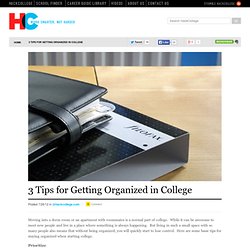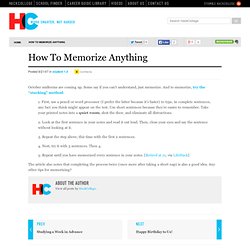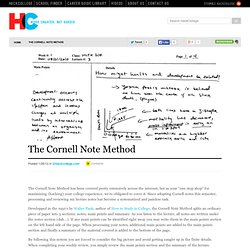

► I still believe in heroes. 3 Tips for Getting Organized in College. Moving into a dorm room or an apartment with roommates is a normal part of college.

While it can be awesome to meet new people and live in a place where something is always happening. But living in such a small space with so many people also means that without being organized, you will quickly start to lose control. Here are some basic tips for staying organized when starting college. Prioritize When packing to move, distinguish between what you want and what you need. Priorities are super important in college because there is no one to bug you about things like studying, how you spend your money, or the amount of partying you do.
Do Double Duty Living in a dorm or apartment with roommates means you will be putting a lot of people (and all of their stuff!) Get Creative When it comes to maximizing space, the key is to get creative. What tips do you have to offer to Freshman getting ready to move into a dorm or apartment for the first time? How To Memorize anything. October midterms are coming up.

Some say if you can’t understand, just memorize. And to memorize, try the “stacking” method: 1. First, use a pencil or word processor (I prefer the latter because it’s faster) to type, in complete sentences, any fact you think might appear on the test. Use short sentences because they’re easier to remember. The article also notes that completing the process twice (once more after taking a short nap) is also a good idea. View all posts by HackCollege. How To Generate Good Ideas. Our friends at Column Five Media have recently produced a motion graphic video in support of their newest product – a book about Infographics.

The name? Infographics. Their latest blog post spills the details: This spring, we set out to answer the question “Where do good ideas come from?” In the form of a motion graphic that would serve as a companion piece for a course we developed for Columba University’s Graduate Program in Information and Knowledge Strategy (Visualization of Information) . Check out Column Five’s new video, called How To Generate Good Ideas: How to Generate Good Ideas from Column Five on Vimeo. 3 Ways to hack your STUDY. Today’s post is by Ryan Nguyen, a UC Santa Barbara, CA student who writes for our friends over at CollegeInfoGeek.
Ryan is also a soon-to-be medical student, and blogs about his premed journey on PracticalPremed. Most students are terrible at studying. Perhaps it’s not entirely our’ fault. With so much emphasis in school placed on what to study, it’s no wonder that how we study gets lost by the wayside. One of the strengths of the traditional education system is that it does a great job of teaching the progression of concepts. It’s time to re-think the way we study. Want to get better grades and actually learn what’s being taught in your classes? Guess what? Dig a little deeper and how do most students traditionally study? So if everyone is studying the same way from the same set of notes, what then becomes the key-determining factor for distribution of grades?
Time. The students who can put in the most time studying end up earning the best grades. There had to be a better way. The Cornell Note&Method. The Cornell Note Method has been covered pretty extensively across the internet, but as your “one stop shop” for maximizing (hacking) your college experience, we’re obligated to cover it.

Since adopting Cornell notes this semester, processing and reviewing my lecture notes has become a systematized and painless task. Developped in the 1950’s by Walter Pauk, author of How to Study in College, the Cornell Note Method splits an ordinary piece of paper into 3 sections; notes, main points and summary. As you listen to the lecture, all notes are written under the notes section (duh…). If any main points can be identified right away you may write them in the main points section on the left hand side of the page.